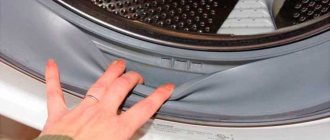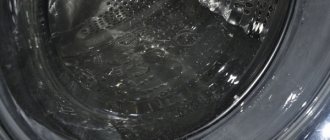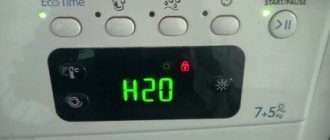Home/Home tips/Washing clothes at 60°: normal or error?
Many housewives rely on automatic machine modes when washing and do not ensure that the water temperature matches the characteristics of the fabric - material, color, etc.
The opinion that it is necessary to wash clothes exclusively in hot water has long been considered erroneous. Modern powders cope well with dirt even at 40°C. But washing at high temperatures, on the contrary, can only harm the fabric. Its fibers may become stiff, and the item's former appearance may be lost.
So, how do you understand the washing modes and the choice of temperature?
To choose the right temperature, you need to pay attention to the labels attached to the clothes. For example, some fabrics should be washed exclusively in a gentle cycle (temperature up to 30°C), while some should not be washed at all (in this case, dry cleaning can be used).
The choice of temperature depends largely on the type of fabric. Each type of fabric has features that should be considered in more detail.
Synthetics
Synthetic fabrics have a lot of advantages: they are beautiful, wear-resistant, durable, and retain heat well. However, these fabrics are a little capricious - they cannot withstand high temperatures. Therefore, when washed at 60°, synthetics immediately lose their qualities. The permissible temperature in this case can vary from 30 to 50°C. Clothes made from synthetics should be washed more often, but in no case should you rub them with force, as the fibers of the fabric can become deformed. Spin in a terry towel is allowed. Hang such clothes using hangers.
How to choose a washing temperature in a washing machine
In many washing machines, a washing program is first selected, which includes, among other things, the washing temperature.
For example, the “delicate wash” program means washing at 30-40 degrees, and the “intensive wash” for cotton items - 90 degrees.
Other models of washing machines allow you to choose the washing temperature yourself.
To choose the right temperature at which you will wash things in the washing machine, follow the following scheme:
- in cold water, that is, up to 30 degrees, wash silk and woolen items, thin delicate linen, lace items;
- Also, clothes made from mixed fabrics, if they contain wool or silk, and items made from artificial silk, are washed in cold water;
- It is recommended to choose a temperature of 30-40 degrees for washing jeans so that they do not fade or lose their shape; This temperature is also suitable for washing synthetic down jackets;
- at a temperature of 40 degrees, lightly soiled linen, colored cotton and synthetic items, such as tulle curtains, are washed;
- some types of synthetics are washed at higher temperatures - up to 50 degrees, these include nylon, nylon and lycra; for fabrics made from a mixture of cotton and synthetics, you should choose the same washing temperature;
- 60 degrees is a suitable temperature for moderately to heavily soiled non-fading cotton items, such as bed linen, toilet and kitchen towels, and baby clothes;
- wash at high temperatures - up to 95 degrees is acceptable for disinfecting and washing heavily soiled cotton and linen items.
However, do not forget that even permanently colored fabrics will lose their brightness when washed in hot water, and frequent washing at high temperatures leads to rapid wear of washing machine parts.
Cotton
Cotton items must be sorted by color and degree of soiling before washing. 100% cotton fabrics are subject to shrinkage. They must be washed at low temperatures - from 30 to 40°C. When washing cotton, the choice of powder is very important. The best solution is powders with enzymes. For dense fabrics, a spin speed of up to 800 rpm is allowed. Do not use automatic drying. It is better to straighten the item and, without waiting for it to dry completely, start ironing. This will help avoid wrinkles and maintain its shape.
Some additions about the correct temperature to wash things at
To choose the right washing temperature, do not forget that the higher the water temperature and the more often you wash in hot water, the faster things become unusable.
Even the gentle wash cycle won't help. Therefore, even for very dirty items, it would be better to choose washing at a lower temperature.
To ensure that things are still washed efficiently, try:
- increase the amount of detergent;
- choose a better quality washing powder;
- Use a soak or prewash cycle.
If special detergents are used for washing, such as laundry shampoos, products with enzymes, products for membrane fabrics, then when choosing the washing temperature, follow the instructions on the package. Otherwise, detergents will lose their effectiveness and the washing result will not live up to expectations.
Silk
Silk is an attractive and durable fabric that retains warmth and allows the skin to breathe. However, silk products require special care. Silk fibers are soft and loose and can lose strength when wet. Therefore, silk is washed at a temperature of 20 to 30°C. If you wash silk at a higher temperature, there is a risk of ruining the product: the silk may lose color, and the fibers may swell and fray. When rinsing items, you can add vinegar to make the colors of the fabric more vibrant. The spin mode should be selected as low as 400-500 rpm. Silk items should be dried using hangers.
Modes on the washing machine
It became customary to wash yellowed, gray, and complex stains at high temperatures. But this washing is fraught with several serious complications in the future. In addition, it is unwise to rely only on high temperature, because the cleanliness of things also depends on the products that are used during or before washing. A quality stain remover can work even in cool water.
Poplin, cambric and bamboo
These are natural fabrics that can withstand washing at 60°C, but in some cases the recommended temperature is 40°C. These items are washed on a delicate cycle. Depending on the type of fabric, you should choose a mode with a number of revolutions from 800 to 1200. Caring for these materials is simple. Products made from poplin, cambric and bamboo are easy to wash. You can dry them either using an automatic dryer or in the usual way - in a dryer.
Manufacturers of washing machines have made sure that washing is a simple and enjoyable experience. Many machines are equipped with various washing modes, which allow you to preserve the quality of your clothes for many years. However, the choice of these modes, including temperature and speed, remains ours. Every housewife should know how to use them as efficiently as possible.
AlinaAuthor of the article
Did you like the article?
Share with your friends:
Comments (3)
- lelik March 3, 2022 at 6:34 pm
bamboo is not a fabric, especially since it is not natural, just like viscose, but poplin and cambric are cotton fabrics
Answer
- Sergey March 14, 2022 at 9:48 am
Where have you seen artificial bamboo?
Answer
- Mari March 13, 2022 at 10:38 am
In the washing manual, they write the names of the fibers from which the fabric is woven or knitted (bamboo, silk, viscose, cotton, linen, wool), and not the names of the fabrics according to the method of weaving the threads (calico, poplin, cambric, crepe de Chine, drape). Names of fabrics are needed more by dressmakers than by laundresses :) Poplin can be silk, cotton, or bamboo, but all three types of this fabric will be the same in appearance - fine ribbed, but different in terms of washing conditions.
And, by the way, bamboo fabric comes in two types: expensive “bamboo-linen” - made from fiber treated with enzymes, and cheap “bamboo-viscose” (another name is rayon), treated with alkali or carbon disulfide.
Answer
Lower temperatures do not get rid of dirt
If we move from cost savings to another practical issue, namely the efficiency of the wash itself, we must state that higher temperatures clearly win in this area. Various tests have logically shown that 30 degree programs clean laundry better, while 20 degree programs are still not sufficient for certain types of stains such as olive oil stains, for which 40 degree programs are short and should be 60 degrees.
So, when a gentle approach to -30°C is required, a 30-step wash is more suitable for clothes that require mostly everyday washing rather than targeted stain removal, and also require gentler handling due to the material they are made from. done. This applies, for example, to sportswear, outerwear or wool.
Selecting the washing temperature according to the instructions on the labels
When choosing the correct washing temperature, follow the instructions on the special labels.
Such tags may indicate both the washing method and the washing temperature.
List of special icons for streaking in the washing machine:
- Wave sign in the washing container - the item can be washed in a washing machine, including in the quick wash mode.
- A crossed out basin with a wave - washing is prohibited.
- The outline of the washing machine is in a circle - machine washing is prohibited.
- One line under the basin of water is the gentle wash icon.
- The number 30 and one line at the bottom is a gentle wash icon at 30 degrees.
- Two lines under the water container are an icon for delicate laundry.
- A hand dipped into a basin of water is an icon for hand washing.
- A water container without a wavy line with the number 95 inside is an icon for washing with boiling water at temperatures up to 95 degrees.
- Inside the basin, the number 50 is an icon for washing colored laundry at a temperature of 50 degrees.
- The number 60 is an icon for washing colored items at 60 degrees.
- Inside the icon is the number 40 - an icon for washing colored items at 40 degrees.
- The number 30 on the wash icon means wash in warm water at a temperature of no more than 30 degrees.
By choosing the right washing temperature, you can ensure washing efficiency and increase the life of your items.
Wash in cold water
1. Wash clothes on a cold cycle.
The first advantage is that you save energy. In addition, you don’t have to worry about the cleanliness of the clothes you wash. Modern detergents allow you to wash stains and dirt even in cold water.
If you have a good powder, the effectiveness of cold water is no less than that of hot water.
2. Use the usual amount of detergent even when washing in cold water.
Contrary to what you may have heard before, when washing on cold cycles, you don't need to use more powder to be more effective.
Use the same amount of detergent as you are used to adding when washing in hot water.
3. You need to know when to use hot water.
If you need to disinfect things or wash them from heavy dirt, only in this case should you choose a hot water washing mode.
It is recommended to select the hot mode when you wash, for example, kitchen or bath towels.
In other words, items, prefer high temperatures if you need to wash items that collect more bacteria than other types of laundry.
In addition, proponents of cold water washing cite three more compelling arguments in favor of low temperatures:
-First, hot water spoils things.
Many have heard stories that it is hot water that disrupts the structure of fabric fibers.
First of all, this applies to woolen items, as well as a number of other delicate fabrics. Surely, some of us have encountered a situation where, after washing in hot water, a favorite cardigan shrunk hopelessly and could only be worn by a child - it suddenly became so small.
But a thing made of another material, on the contrary, after washing it stretched so much that it was just right to give it to your mother or older sister.
How do you like holes that formed not at the seam, but just out of the blue? Unfortunately, this situation is far from uncommon.
The main reason is fibers that become thinner under the influence of hot water. As a result, a few washes are enough for hot water to completely destroy the fibers, ruin the item and lead to the formation of those same holes.
Of course, an item with holes is a completely damaged item that cannot be restored.
-The second argument is that when washed in cold water, fabrics retain their color longer and do not fade.
Again, each of us has had a situation when a bright red blouse suddenly lost its color and turned into a faded dirty burgundy thing. This happened because hot water has the ability to wash away bright and rich shades.
— And finally, the third argument in favor of washing in cold water is the absence of white stains, which often appear on clothes after washing in hot water.
Dark things especially suffer from white stains. In cold water there will be fewer stains on black things.
And, of course, as mentioned earlier, an important argument for washing on cold cycles is electricity bills, which, undoubtedly, will be several times less than bills for hot water.
Every time you turn on the washing machine, it always takes a huge amount of energy to heat the water.
Washing on cold modes allows you to forget about all of these problems. Therefore, resort to hot water only in extreme cases, when it is truly necessary.
Do-it-yourself faults and repairs of washing machines
Most automatic washing machines are equipped with a “boiling” function, i.e. washing takes place for some time at a maximum temperature of 90 degrees.
If you look at it, this is not entirely true. This water temperature in the washing machine tank is reached for no more than a few minutes. So the opinion that once you turn on the machine to boil, it means it will boil for the entire 2 hours of operation is not true. What makes you come to this conclusion? Service centers began to receive complaints that washing machines did not reach a temperature of 90 degrees C in the “boil” washing mode. An analysis of the work was carried out by measuring the temperature of the water in the washing machine tank, and the result was obtained - the water heats up to the desired temperature, but for no more than a few minutes, then the heating element of the washing machine turns off, and there is a smooth decline.
The maximum achieved water temperature in the tank was 86 degrees C at the 37th minute of operation of the washing machine. So, our washing assistant boils, it turns out, not as long as we would like.
How many degrees is the water temperature for a cold wash?
Most manufacturers of modern washing units include a “Cold Wash” mode in the machine’s functionality, with which you can guarantee special care for thin and delicate fabrics. The program works as follows: after loading the laundry into the drum and activating the button with the appropriate name, the intake from the water supply system begins, but the heating element does not turn on and the water does not heat up.
Do not confuse the “Quick Wash” and “Cold Wash” modes. The difference between them is that in the first case, the water still heats up, albeit a little, only up to +30 degrees, but the heating element must turn on, and a certain amount of electricity is spent on this.
The water temperature during “Cold Wash” is the same as in the water supply:
- In the summer, it can reach +25°C and even +30°C.
- In winter it drops to +15°C.
- Residents of the private sector use wells or wells in which the water can be almost icy, down to +2°C.
Due to the fact that detergents are almost insoluble in liquids with temperatures below +10°C, it will not be possible to carry out high-quality cleaning in such conditions without heating.
What does a washing machine cycle consist of?
During operation, the automatic machine goes through several stages. The cycle consists of:
- washing;
- rinsing;
- spin
Often during washing this cycle is carried out not 1, but 2 or 3 times. This will depend on the mode and program selected.
In addition to the main 3 stages, there are also additional ones, which also determine how long the automatic washing machine takes to wash: pre-wash and additional rinsing. Some programs have these steps, others skip them. It will also take time to heat the water, drain it and fill it. There are many such additional factors, so it is worth dwelling on them in more detail.
Using hot water
The maximum water heating is 60˚C. Hot water allows you to eliminate the most difficult stains on clothes and other things. First you need to pre-treat with detergent, but soaking may not be necessary.
Bed linen and children's clothing need intensive washing, because these products most often become heavily soiled. Such things include various towels and work clothes, because these products are constantly in use.
The washing machine washes with cold water: reasons
The heating element is responsible for heating the water entering the machine. This is a tubular heater that is found in every laundry appliance. The unit is connected to the cold water supply network. It takes some time to heat up to the desired temperature: depending on the power of the machine and the selected program, from 5 to 20 minutes. Therefore, if you touch the hatch and it does not heat up at least a little, perhaps the required time for heating has not yet passed. If the washing machine runs its normal cycle, the washing temperature is set to more than 30 degrees, and the hatch remains at the same temperature, then most likely the heating element has failed. It often forms scale and a layer of “dirt” from small fluff from clothes being washed, impurities in the water, and powder residues. As a result, it stops heating and heating the water. The problem is easily solved - the heating element can be replaced. This does not affect the operation of the machine in any way; after replacement, it will last for many more years. This is one of the most common problems with washing machines.
There are other reasons why a washing machine washes with cold water:
- The temperature sensor is broken. It determines how hot the liquid is in the machine and, in accordance with this, sends commands to the control unit. When it breaks, it does not recognize that the water is cold and does not give the command to heat it. If the temperature sensor is acting up, it can be replaced.
- Problems with the electronic control unit. The board elements or the tracks between them, responsible for heating, may burn out. In this case, you can replace individual parts, solder faulty tracks, or install a new control unit.
- Damage to wiring or contacts. They oxidize or wear out from prolonged use or excessive vibration if installed incorrectly. In private homes, rodents may be a problem. The wiring is changed or repaired: contacts are soldered, wires are twisted.
Using boiling water
Boiling water is used not only for cleansing, but also for disinfection. The use of boiling water is allowed only for certain types of fabrics:
- Things that are intended for newborns.
- Textile toys.
- Items intended for people suffering from skin diseases.
- Medical things.
You can wash ordinary clothes in boiling water, especially when it is necessary to remove very stubborn stains. But boiling water can be used if other types of washing have not helped remove stains. However, boiling is prohibited for cleaning delicate items, wool and knitwear.
How to wash so that things don’t shrink and look great?
Let’s not drag our feet and get straight to the mandatory recommendations before washing things.
So, you should divide the process of cleaning clothes using a washing machine into 5 stages:
Dirty laundry before washing. Buy a basket with holes for your home, place it in the bathroom, or where it will not attract attention and carry unpleasant odors. Holes in the basket for dirty things are needed so that stains do not become saturated with dampness and do not eat into them even more.
- Sort your clothes. Don't throw everything in one go. It is necessary to divide clothes into: black, white, colored. Distribute over tissues. Load items that are too dirty separately. Know which materials can fade a lot. Also, it is not recommended to wash shoes without a cloth inside the drum. We'll explain why later.
- Checking everything and everyone. If you don’t want to break your machine or wash your phone, check your pockets. You don’t want to wash your money or passport, right? We recommend tying your shoelaces, zipping your shoes, and leaving the buttons open. Turn your pants inside out and straighten your shirts.
- Pawn correctly. The most important rule is not to clog the machine. An overfilled drum will not wash clothes properly. Even worse - it will break. Remember: you can fill the entire drum with cotton clothes, half with synthetic clothes, and one third with wool. Pay attention to the recommendations of the manufacturer of the clothing brand. The tag always indicates the temperature, mode, and time.
Select the program and power based on the information on the label. If it is not saved, then use our guide:
- Cotton and linen – maximum rotation speed, temperature 95*
- Colored items - in water up to 60*, spin at any speed.
- Synthetics – temperature no higher than 50*, spin speed 800-900.
- Wool, silk - at a temperature of 40 *, spin at 600 rpm.
- If you know that things shed, wash them in water up to 30*.
Tips for washing a down jacket
Tips for washing a down jacket or ski jacket will help maintain the aesthetics of this item of clothing and extend its use. In particular, you need to pay attention to the following recommendations:
- There is no need to pre-soak the down jacket.
- You can go over problem areas (pockets, seams, side areas where bags rub against, collars, sleeves) with a brush coated with a stain remover.
- Wash the down jacket fully buttoned (all buttons, hooks and zippers must be fastened).
- Unfasten the fur (if any). It is washed separately.
- Use a gentle wash cycle.
- Do not use powders that contain coloring or bleaching agents. The best choice is baby powder without additives or a special product for down products.
- Place 3-6 tennis balls or special laundry balls into the drum. When choosing the quantity, be guided by the size of the down jacket. This simple method will prevent lint from clumping into clumps.
- Include an extra rinse, as it is very difficult to get rid of detergents in fluff.
- Wring out the down jacket at minimum speed in delicate mode. There is no need to take out tennis balls.
- Dry the down jacket in the fresh air, kneading the down with your hands from time to time to break up any lumps. You can also dry directly in the washing machine by selecting the “Spin without rinse” mode. The balls must be inside the machine.
Important! You cannot dry a down jacket by laying it horizontally. Wet storage is also unacceptable.











